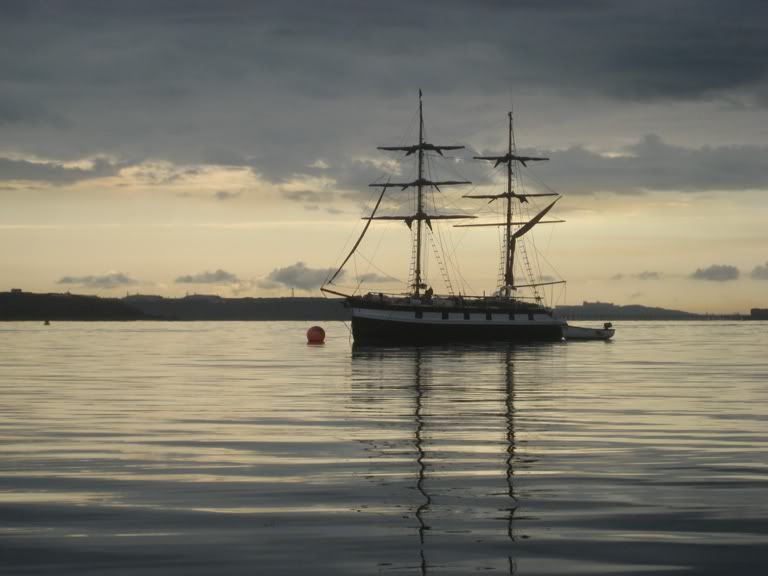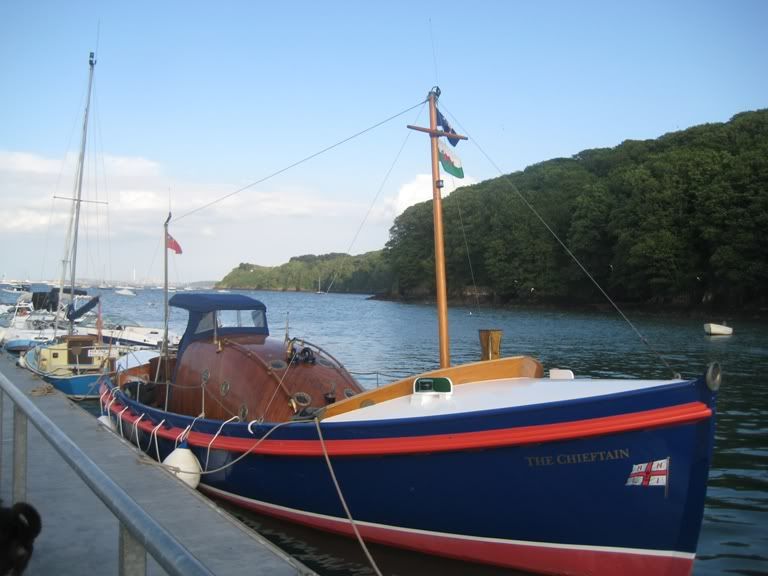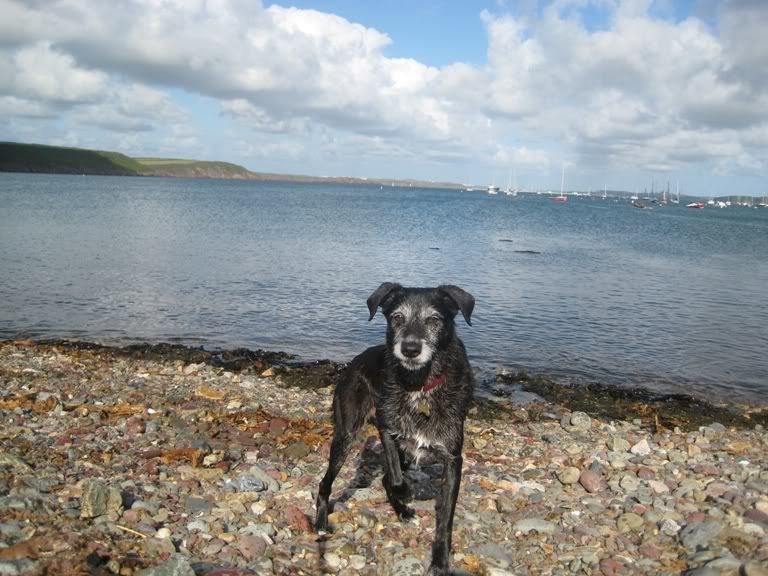Following our exploits of a couple of weeks ago sailing Paschall's junk rigged Kingfisher 26, I became interested in junk rigs, and the people who sail them. A bit of reading soon brought me to Roger D Taylor, and his junk rigged coribee MingMing. I ordered both of Roger's books, 'The Simple Sailor' and 'MingMing and the art of minimal ocean sailing'.
MingMing
Here was a chap who sets off every year on an Ocean voyage, typically to the frozen North, Iceland, Greenland and so on, in a tiny boat, single handed, with no GPS, radar etc and expounds the idea of minimalist sailing.
How refreshing! Pure sailing. In these days of high performance sailing gear and gadgets, and even higher performance selling of such items, it really is good to read page after page of descriptions by someone who clearly loves the sea, all of its moods and the creatures, whales, dolphins, birds, that share it with him.
"Ah yes, the sea! What can you say? It rolls on and on and the wind blows. What impels a man to ride those billows, day after day after day? Why this yearning? What madness is it, that finds solace in an indifferent wilderness? Is it return or escape? Is it to touch the heart of life or to caress the cool cheek of death, distantly? What is this thing that hovers, never seen but always there, and draws a man on? What is this lodestone? Why the sea, always the sea?" *
*from Mingming and the art of minimal ocean sailing.
"Why the sea, always the sea" - it's a question I've been asking myself for years now. Whatever I do, wherever I go, I find myself looking at, floating on or swiming under it.
Roger's descriptions of calms, of storms, of solitude, the beauty and terrible power of the sea captured me totally for the couple of days I spent reading his words.
I thoroughly enjoyed the books.
Tuesday 28 June 2011
Monday 27 June 2011
The boat I nearly crossed the Atlantic on......
She's called Chelone, and she's a Hans Christian 38. We met her owner, John, through another friend, Tom. John was taking Chelone from Neyland to the Caribbean last October, and returned to Neyland just a few days ago, after crossing back single handed.
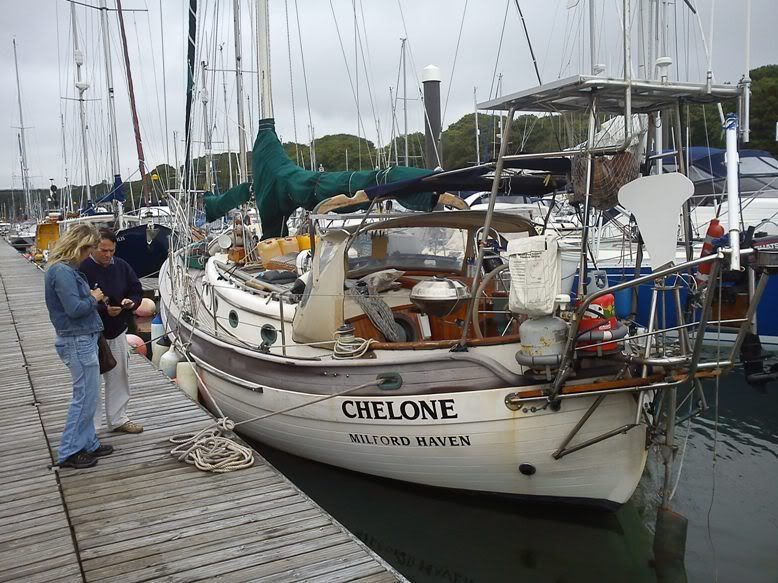
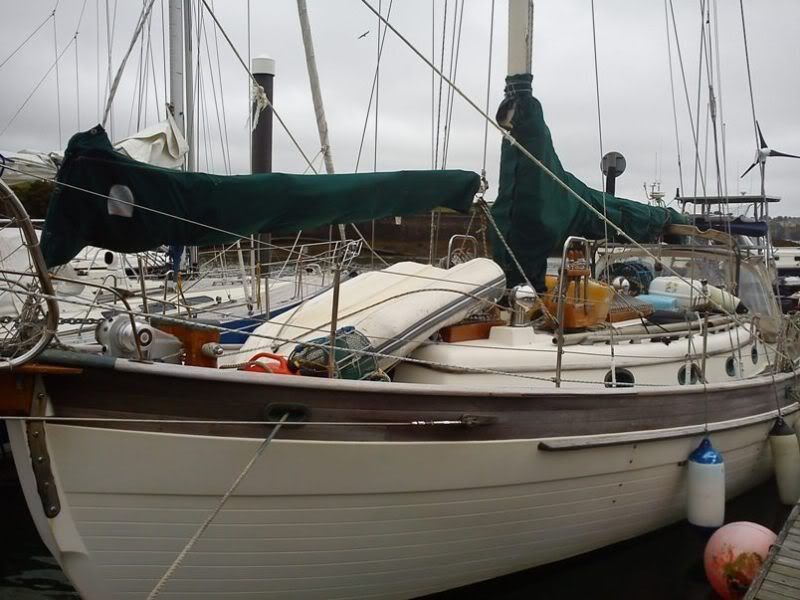

John had spoken to me when he'd been looking for crew, and I'd loved to have made the trip, but finances and timing were not right, so I didn't go. We met up with John yesterday, to hear tales from his trip, but need to see him again when we have more time, to hear much more, and, of course, to pick up tips and tricks, if we ever hope to do similar ourselves one day.

Friday 24 June 2011
Sailing and diving - Lundy
Huw, a friend at Cardiff yacht club had planned a trip to Lundy, sailing there, doing a bit of diving and sailing back. It coincided with my birthday, and, having never dived Lundy, but loved the place when we sailed there in Ishtar a couple of years back, I really fancied the trip.
We met at Cardiff yacht club on the Monday morning. Huw was taking Camelot, Steve was taking Coracle, his Moody 27
[caption id="" align="alignnone" width="300" caption="Camelot and Coracle"] [/caption]
[/caption]
And Carl, with crew Gareth, was taking Samson, as the dive boat:
[caption id="" align="alignnone" width="300" caption="Samson, skipper Carl"]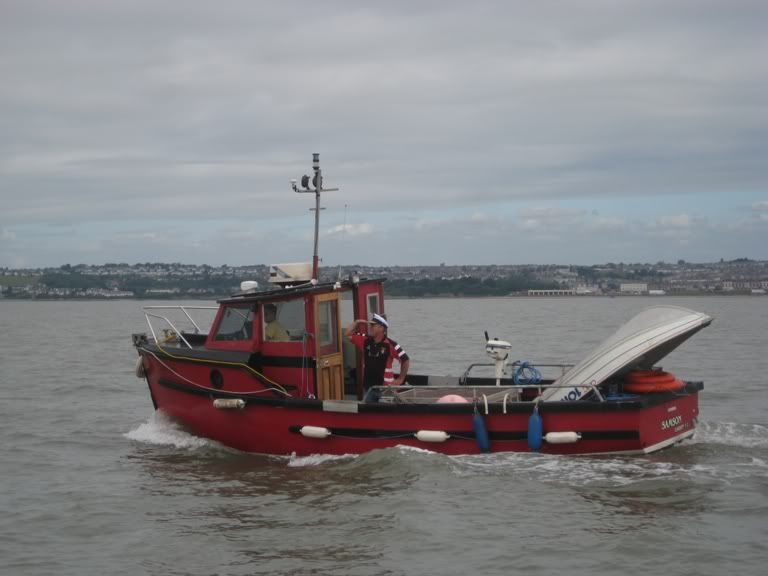 [/caption]
[/caption]
We locked out at 08:30, under blue skies and light winds
[caption id="" align="alignnone" width="300" caption="Leaving Cardiff"]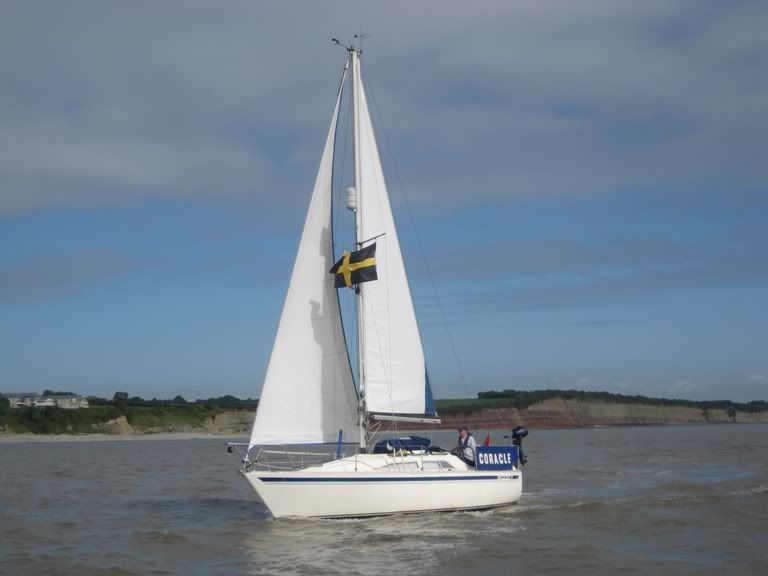 [/caption]
[/caption]
As we neared Ilfracombe, our stop for the night, the weather closed in, miserable and grey, with a heavy drizzle. We were an hour early for our moorings, and struggled to tie up to wait for the incoming tide.
[caption id="" align="alignnone" width="300" caption="Grounded"] [/caption]
[/caption]
We eventually tied up in the inner harbour. Fish and chips ashore, followed by a couple of pints in a quiet Ilfracombe Yacht club was followed by a good night's rest.
We were joined by a couple of other divers, Seamus and Darren, workmates of Huw, in the morning,. We set off for Lundy in blustery conditions, wind F5-6, Westerly, and gradually bashed our way through big Atlantic swells, Samson suffering more than the two yachts as we headed Westwards into the strong winds. Carl had mentioned a filter blockage on the way to Ilfracombe and encountered the same problem in the swells half way across. Changing the filter was unpleasant to say the least, given the conditions.
Three and a half hours later and we were at the anchorage on Lundy, a a calm and peaceful haven, water flat and blue - a huge contrast to the white water and swells we'd encountered on the way over.
[caption id="" align="alignnone" width="300" caption="Lundy anchorage"]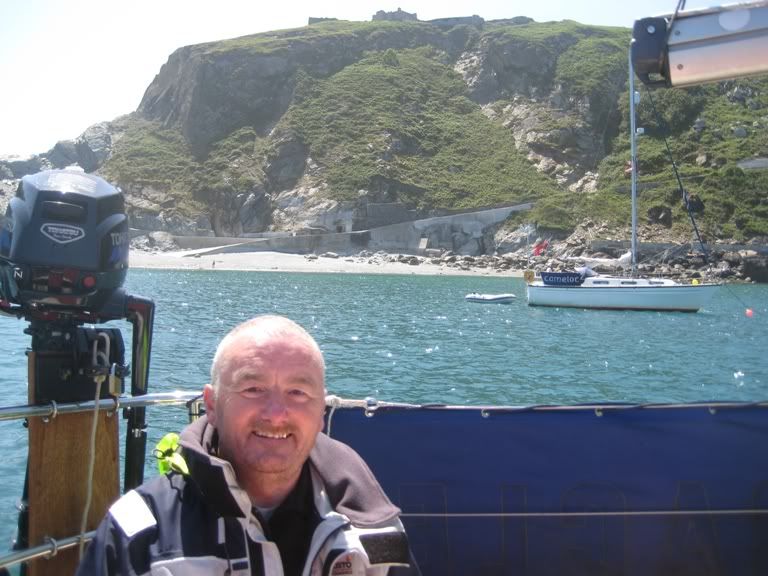 [/caption]
[/caption]
We quickly kitted up for a dive on the coaster 'Robert', which sank in 1974. Only three of us fancied the dive - the others were still recovering after the lumpy crossing and fuel problems. I really enjoyed the dive, although a few problems with my scuba gear meant that it was shorter than I'd planned. The visibility was also less than expected, with a heavy plankton bloom in progress.
[caption id="" align="alignnone" width="300" caption="Diving the 'Robert'"]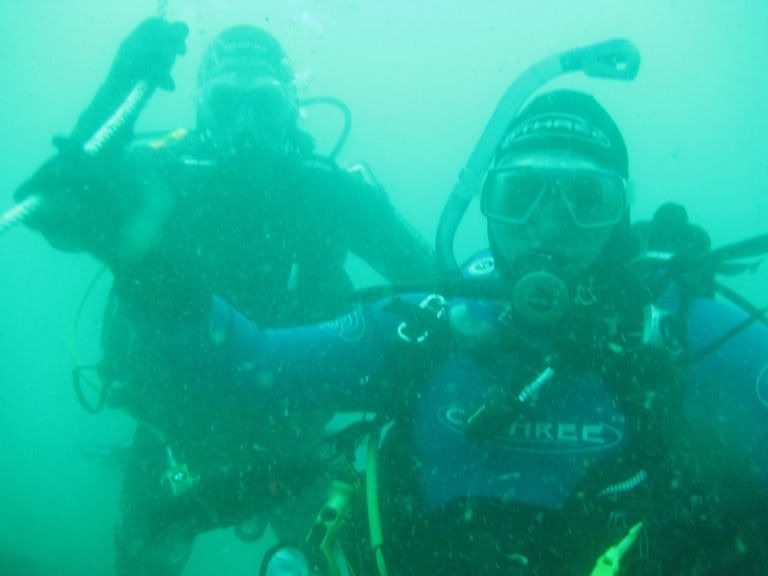 [/caption]
[/caption]
After the dive, Samson's engine again cut out. A third filter was blocked. When we saw it, filled with black slime, a couple of us quickly realised that the dreaded Diesel bug had struck again. I was particularly concerned, given that this was the dive cover boat, and we were 20 miles or so offshore. The weather was not improving, either, so a rough pasage back to Cardiff was certain. We added some diesel treatment and headed back to the mooring.
A quick jaunt up the steep incline to the Marisco Tavern was organised, with the obligatory stop half way for pictures of their boats taken by proud owners. The walk back, at 23:30, in a light drizzle, strong winds and virtual pitch blackness was interesting.
A couple more dives the following day, at 'Gannet Bay' and the Robert again (The West side and tips of the Island were undiveable in the rough weather). The visibility was even less, at around 4m, but I did spot a tiny fish, living, it seemed, inside a jellyfish:
[caption id="" align="alignnone" width="300" caption="Fish with Jellyfish"]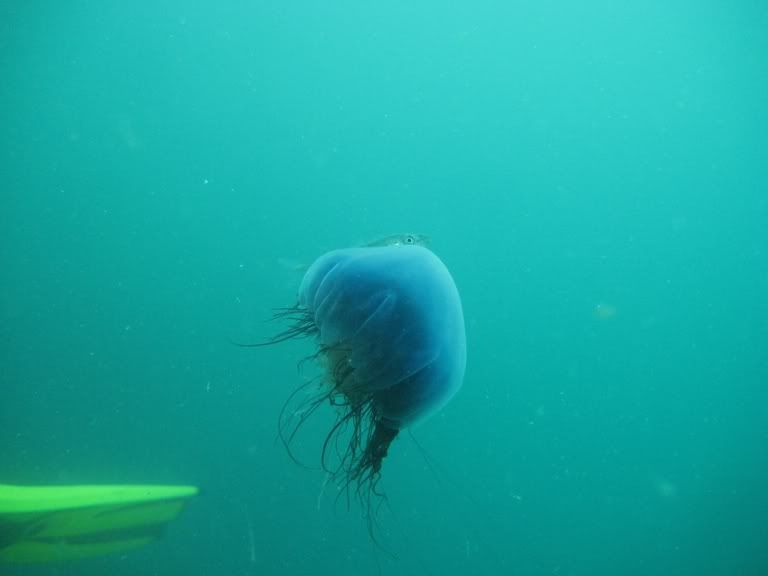 [/caption]
[/caption]
It kept darting inside the jellyfish as I tried to take pictures, but you may be able to make it out just behind the jellyfish in the above picture.
All too soon it was time to return to Ilfracombe. The flood started at 17:30, so we'd have wind with tide for the trip. As the three boats prepared to leave, I was again spellbound by Lundy's beauty
[caption id="" align="alignnone" width="300" caption="Leaving Lundy"]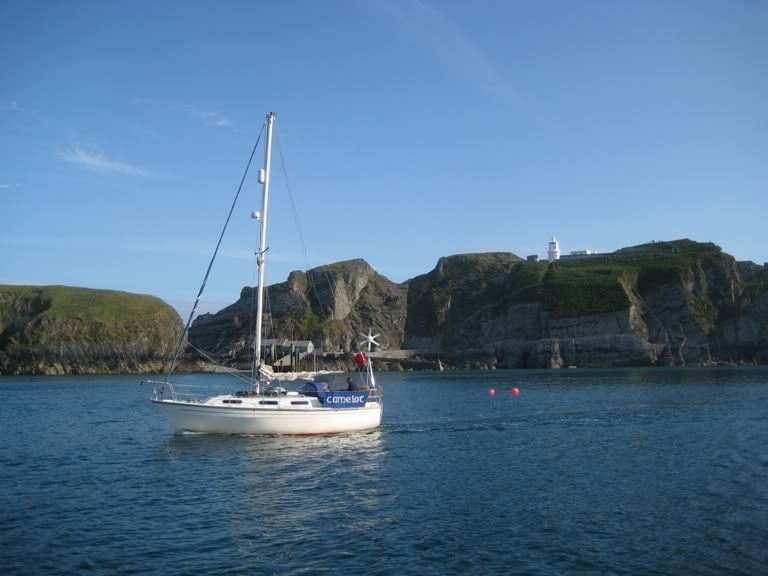 [/caption]
[/caption]
The best sail I've had this year then followed, with a dead run back to Ilfracombe in a Westerly Force 6. Steve's 27ft Moody rode the waves superbly, as the island faded in the evening sun.
[caption id="" align="alignnone" width="300" caption="Eastwards"]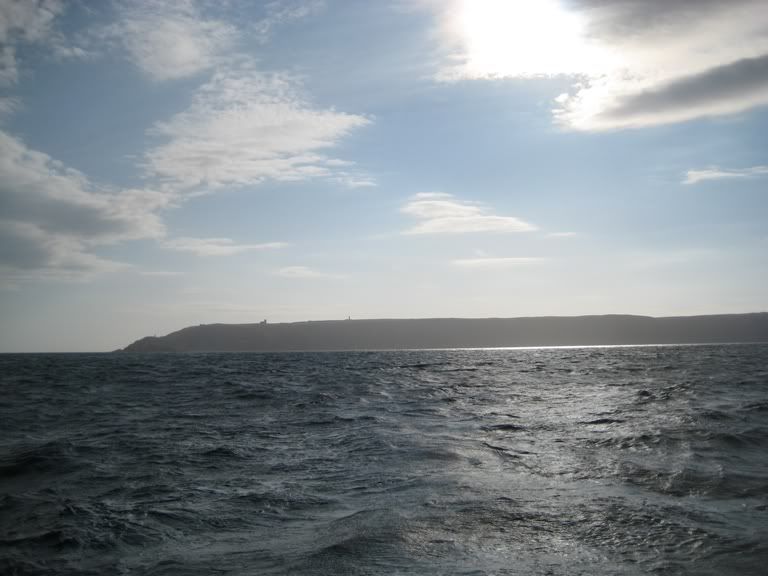 [/caption]
[/caption]
[caption id="" align="alignnone" width="300" caption="Camelot"] [/caption]
[/caption]
[caption id="" align="alignnone" width="300" caption="Camelot"]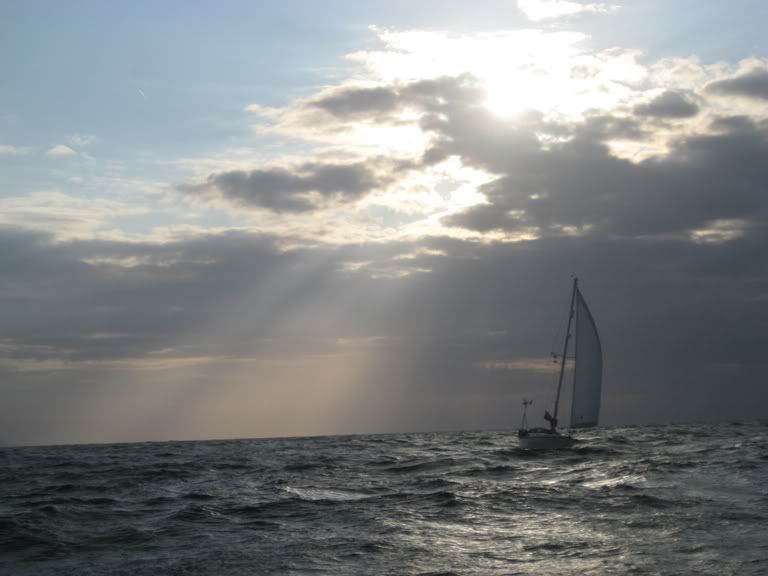 [/caption]
[/caption]
We arrived at Ilfracombe just after 22:00, exhilerated, and very tired. Quickly tied up in the outer harbour, and, with our depature time of 02:30 hrs fast approaching, headed for our bunks.
[caption id="" align="alignnone" width="300" caption="Ilfracombe"]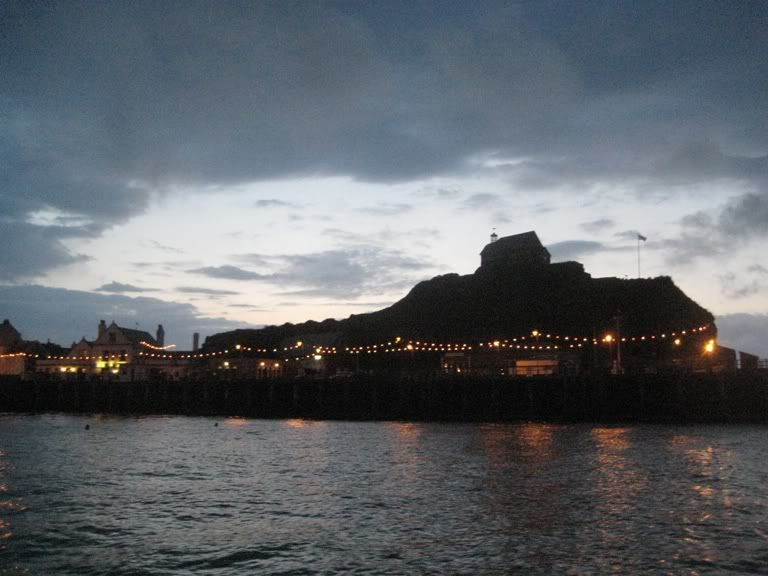 [/caption]
[/caption]
Steve and I rose and slipped our mooring lines just after 02:30. Heavy rain as we climbed out innto the cockpit quickly stopping. I was surprised at the 20 knot Westerly winds as we inched our way out of the harbour in the blackness - the forecast was for a Force 3-4, rather than a 5. As we turned to head ENE, an easy 2m swell lifted and lowered us, Foreland point light blinking, ever closer as the dark gave way to an early dawn after 03:30.
By 05:30 the flood was well under way and the sun was up. Coracle was sailing along at 6 knots over ground under Genoa alone. Steve was happy for me to head below for an hour's sleep as we headed for Cardiff.
An hour later, I awoke to find myself in mid air, having been thrown across the saloon. I climbed out into the cockpit to find much larger waves, some breaking, as did the one that struck us and caused my flight. We were crossing from the English to the Welsh side of the Channel, and the swells, aided by 4 days of winds at Force 5-7, were up to 4m.
[caption id="" align="alignnone" width="300" caption="Mid Channel"] [/caption]
[/caption]
The car transporter that we had been close to when the diesel bug hit us at Portishead was the only other boat we saw as we headed up channel.
[caption id="" align="alignnone" width="300" caption="Car Transporter"]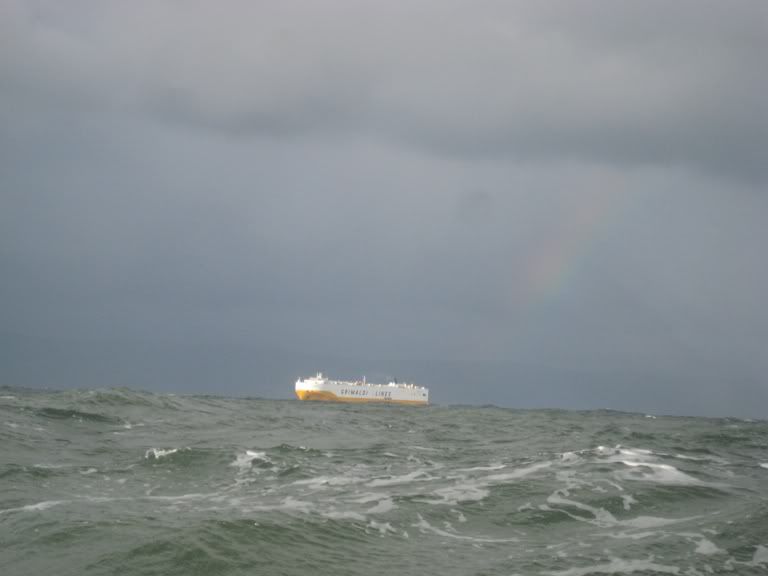 [/caption]
[/caption]
Before long we were locking in at Cardiff, and heading our separate ways. The diving was less exciting than I'd expected, but I'm very keen to return when better weather allows a proper look at Lundy's underwater scenery. The sailing was challenging, but very enjoyable, and the company very good indeed.
We met at Cardiff yacht club on the Monday morning. Huw was taking Camelot, Steve was taking Coracle, his Moody 27
[caption id="" align="alignnone" width="300" caption="Camelot and Coracle"]
 [/caption]
[/caption]And Carl, with crew Gareth, was taking Samson, as the dive boat:
[caption id="" align="alignnone" width="300" caption="Samson, skipper Carl"]
 [/caption]
[/caption]We locked out at 08:30, under blue skies and light winds
[caption id="" align="alignnone" width="300" caption="Leaving Cardiff"]
 [/caption]
[/caption]We punched the last of the flood and then settled into a gentle sail to Ilfracombe with the ebb, flying cruising chutes and then motoring as the winds failed.
As we neared Ilfracombe, our stop for the night, the weather closed in, miserable and grey, with a heavy drizzle. We were an hour early for our moorings, and struggled to tie up to wait for the incoming tide.
[caption id="" align="alignnone" width="300" caption="Grounded"]
 [/caption]
[/caption]We eventually tied up in the inner harbour. Fish and chips ashore, followed by a couple of pints in a quiet Ilfracombe Yacht club was followed by a good night's rest.
We were joined by a couple of other divers, Seamus and Darren, workmates of Huw, in the morning,. We set off for Lundy in blustery conditions, wind F5-6, Westerly, and gradually bashed our way through big Atlantic swells, Samson suffering more than the two yachts as we headed Westwards into the strong winds. Carl had mentioned a filter blockage on the way to Ilfracombe and encountered the same problem in the swells half way across. Changing the filter was unpleasant to say the least, given the conditions.
Three and a half hours later and we were at the anchorage on Lundy, a a calm and peaceful haven, water flat and blue - a huge contrast to the white water and swells we'd encountered on the way over.
[caption id="" align="alignnone" width="300" caption="Lundy anchorage"]
 [/caption]
[/caption]We quickly kitted up for a dive on the coaster 'Robert', which sank in 1974. Only three of us fancied the dive - the others were still recovering after the lumpy crossing and fuel problems. I really enjoyed the dive, although a few problems with my scuba gear meant that it was shorter than I'd planned. The visibility was also less than expected, with a heavy plankton bloom in progress.
[caption id="" align="alignnone" width="300" caption="Diving the 'Robert'"]
 [/caption]
[/caption]After the dive, Samson's engine again cut out. A third filter was blocked. When we saw it, filled with black slime, a couple of us quickly realised that the dreaded Diesel bug had struck again. I was particularly concerned, given that this was the dive cover boat, and we were 20 miles or so offshore. The weather was not improving, either, so a rough pasage back to Cardiff was certain. We added some diesel treatment and headed back to the mooring.
A quick jaunt up the steep incline to the Marisco Tavern was organised, with the obligatory stop half way for pictures of their boats taken by proud owners. The walk back, at 23:30, in a light drizzle, strong winds and virtual pitch blackness was interesting.
A couple more dives the following day, at 'Gannet Bay' and the Robert again (The West side and tips of the Island were undiveable in the rough weather). The visibility was even less, at around 4m, but I did spot a tiny fish, living, it seemed, inside a jellyfish:
[caption id="" align="alignnone" width="300" caption="Fish with Jellyfish"]
 [/caption]
[/caption]It kept darting inside the jellyfish as I tried to take pictures, but you may be able to make it out just behind the jellyfish in the above picture.
All too soon it was time to return to Ilfracombe. The flood started at 17:30, so we'd have wind with tide for the trip. As the three boats prepared to leave, I was again spellbound by Lundy's beauty
[caption id="" align="alignnone" width="300" caption="Leaving Lundy"]
 [/caption]
[/caption]The best sail I've had this year then followed, with a dead run back to Ilfracombe in a Westerly Force 6. Steve's 27ft Moody rode the waves superbly, as the island faded in the evening sun.
[caption id="" align="alignnone" width="300" caption="Eastwards"]
 [/caption]
[/caption]Huw followed in Camelot, his Contessa 28
[caption id="" align="alignnone" width="300" caption="Camelot"]
 [/caption]
[/caption][caption id="" align="alignnone" width="300" caption="Camelot"]
 [/caption]
[/caption]We arrived at Ilfracombe just after 22:00, exhilerated, and very tired. Quickly tied up in the outer harbour, and, with our depature time of 02:30 hrs fast approaching, headed for our bunks.
[caption id="" align="alignnone" width="300" caption="Ilfracombe"]
 [/caption]
[/caption]Steve and I rose and slipped our mooring lines just after 02:30. Heavy rain as we climbed out innto the cockpit quickly stopping. I was surprised at the 20 knot Westerly winds as we inched our way out of the harbour in the blackness - the forecast was for a Force 3-4, rather than a 5. As we turned to head ENE, an easy 2m swell lifted and lowered us, Foreland point light blinking, ever closer as the dark gave way to an early dawn after 03:30.
By 05:30 the flood was well under way and the sun was up. Coracle was sailing along at 6 knots over ground under Genoa alone. Steve was happy for me to head below for an hour's sleep as we headed for Cardiff.
An hour later, I awoke to find myself in mid air, having been thrown across the saloon. I climbed out into the cockpit to find much larger waves, some breaking, as did the one that struck us and caused my flight. We were crossing from the English to the Welsh side of the Channel, and the swells, aided by 4 days of winds at Force 5-7, were up to 4m.
[caption id="" align="alignnone" width="300" caption="Mid Channel"]
 [/caption]
[/caption]The car transporter that we had been close to when the diesel bug hit us at Portishead was the only other boat we saw as we headed up channel.
[caption id="" align="alignnone" width="300" caption="Car Transporter"]
 [/caption]
[/caption]Before long we were locking in at Cardiff, and heading our separate ways. The diving was less exciting than I'd expected, but I'm very keen to return when better weather allows a proper look at Lundy's underwater scenery. The sailing was challenging, but very enjoyable, and the company very good indeed.
Sunday 19 June 2011
Mooring practice
(By Louise)
The weather forecast did not look good for the weekend, southwesterly F6-8 with squally showers. I wanted to go to Ishtar anyway to refit the spray dodgers and trim the carpet that I had begun to fit last weekend. Martin suggested that I take the boat out for a sail on my own. The thought really scared me, not so much the sailing but taking the boat off and then back on the mooring.
Off I went to Dale and after getting the tender sorted and motoring to the boat I pottered about with the spray dodgers until I could put it off no longer.
With the engine running and everything ready I cast off from the mooring. The wind indicator was showing 15 knots westerly but it felt stronger so I let out half the genoa and put the engine into neutral. I was going 5.7 knots S.O.G. With the engine then switched off I felt really exhilarated, I had been so nervous but now I felt excited.
There were not many others about, certainly no yachts, so when I got near Great Castle Head I decided to head for home. I motored back to Dale and slowed right down near our mooring.
The last time I had tried this I managed to run over the tender's painter and I nearly sunk it, so I was very nervous. I slowly edged alongside the tender and having put the boat into neutral I made a dash out of the cockpit, boat hook in hand, and got hold of one of the mooring lines.
Once I had one of our lines on the boat gently drifted back and I could then hook the other line and get the chain on. I was delighted and couldn't wait to ring an anxious Martin to tell him that Ishtar was safely back on her mooring.
A very small step but one in the right direction.
The weather forecast did not look good for the weekend, southwesterly F6-8 with squally showers. I wanted to go to Ishtar anyway to refit the spray dodgers and trim the carpet that I had begun to fit last weekend. Martin suggested that I take the boat out for a sail on my own. The thought really scared me, not so much the sailing but taking the boat off and then back on the mooring.
Off I went to Dale and after getting the tender sorted and motoring to the boat I pottered about with the spray dodgers until I could put it off no longer.
With the engine running and everything ready I cast off from the mooring. The wind indicator was showing 15 knots westerly but it felt stronger so I let out half the genoa and put the engine into neutral. I was going 5.7 knots S.O.G. With the engine then switched off I felt really exhilarated, I had been so nervous but now I felt excited.
There were not many others about, certainly no yachts, so when I got near Great Castle Head I decided to head for home. I motored back to Dale and slowed right down near our mooring.
The last time I had tried this I managed to run over the tender's painter and I nearly sunk it, so I was very nervous. I slowly edged alongside the tender and having put the boat into neutral I made a dash out of the cockpit, boat hook in hand, and got hold of one of the mooring lines.
Once I had one of our lines on the boat gently drifted back and I could then hook the other line and get the chain on. I was delighted and couldn't wait to ring an anxious Martin to tell him that Ishtar was safely back on her mooring.
A very small step but one in the right direction.
Labels:
Female,
Sailing,
single handed
Sunday 12 June 2011
Snake oil
or, not, it seems.
The diesel bug killer, Marine 16, had been in the tank for a week. Louise and I returned to Ishtar for the acid test. We'd remove the inspection plate at the top of the diesel tank and see whether the treatment had indeed broken down all of the slime produced by the diesel bug as well as killing the bug itself, as claimed in the literature. I was highly sceptical, and, indeed, had pumps and spare jerry cans at the ready, for the inevitable draining of the tank.
After around 20 minutes scraping at the bottom of the tank, and transferring the findings and other tank contents to a clear plastic bottle, the biggest lump of slime we could find was, in Louise's own words 'about the size of a quarter of a full stop'. As unlikely as it had seemed, the treatment had killed the bug AND removed all the slime. Cool.
Louise refitted all the pipes and we retired to The Griffin for a beer with Dave, from Mar y Sol.
[caption id="" align="alignnone" width="300" caption="Dave"]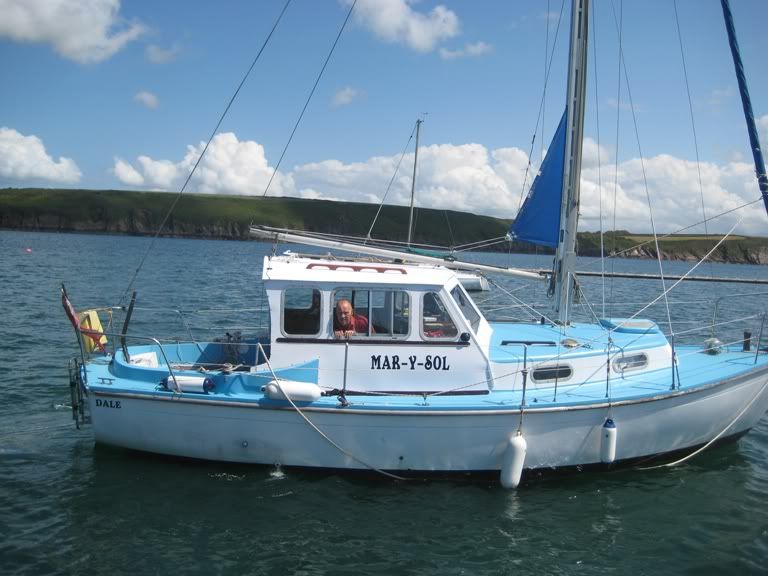 [/caption]
[/caption]
A chilly evening, but we were very happy with the day's result, all told.
The forecast for Sunday was awful, heavy rain and force 6-7 SE winds, with a possible gale. We decided not to stay. Louise took Tigger ashore, passing a friend's trimaran, Gem
[caption id="" align="alignnone" width="225" caption="Gem"]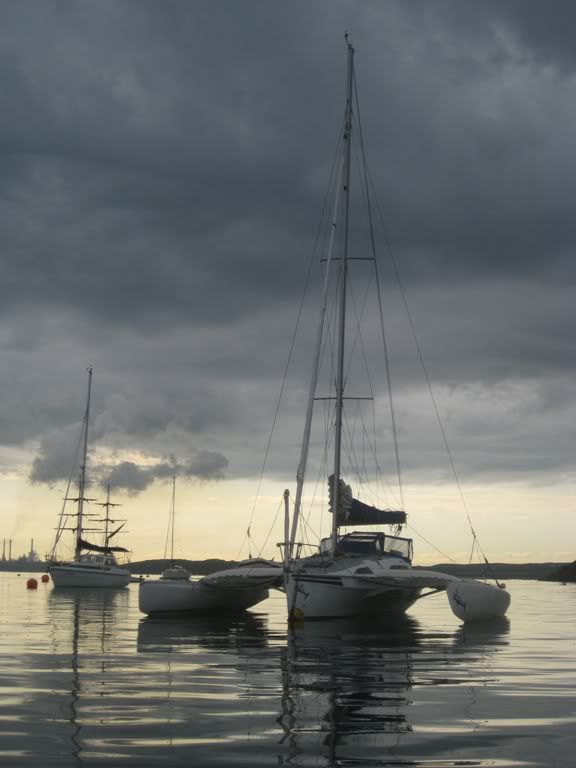 [/caption]
[/caption]
She then fitted the spray dodgers she'd expertly made, and they looked lovely
[caption id="" align="alignnone" width="300" caption="Spray dodgers"]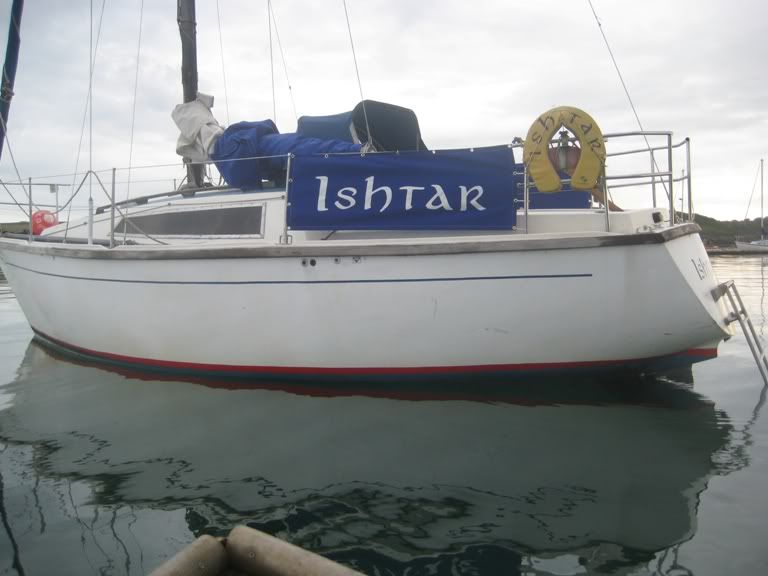 [/caption]
[/caption]
Before we left the boat. We spent the afternoon visiting friends, before returning to Neyland to stay with our friend Tom. The following day saw the promised heavy rain and strong winds, so I think we'd made the right choice. Tom had an idea for a walk
[caption id="" align="alignnone" width="300" caption="Tom"]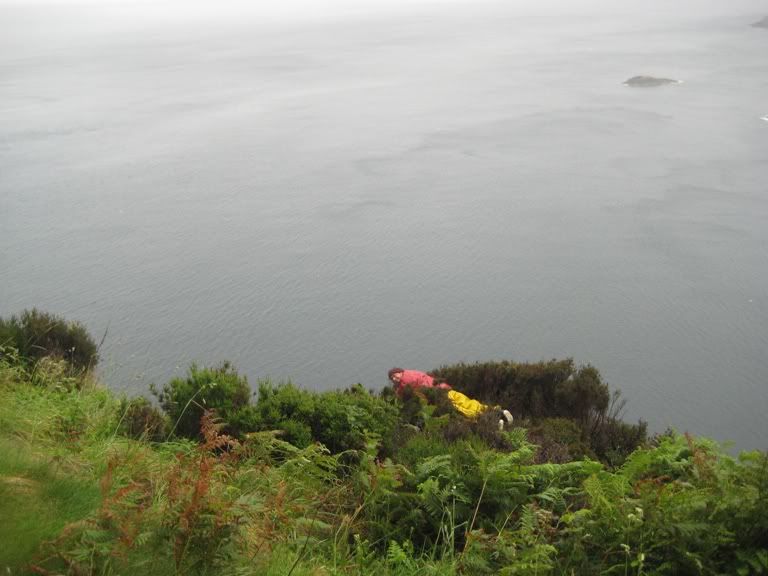 [/caption]
[/caption]
I'm not at liberty to say exactly what two grown men with a combined age over 110 were doing hanging off cliffs in a Pembrokeshire gale, but it would have likely made a good episode of 'last of the summer wine'.
Good fun. Hopefully that's the last of the diesel bug.
The diesel bug killer, Marine 16, had been in the tank for a week. Louise and I returned to Ishtar for the acid test. We'd remove the inspection plate at the top of the diesel tank and see whether the treatment had indeed broken down all of the slime produced by the diesel bug as well as killing the bug itself, as claimed in the literature. I was highly sceptical, and, indeed, had pumps and spare jerry cans at the ready, for the inevitable draining of the tank.
After around 20 minutes scraping at the bottom of the tank, and transferring the findings and other tank contents to a clear plastic bottle, the biggest lump of slime we could find was, in Louise's own words 'about the size of a quarter of a full stop'. As unlikely as it had seemed, the treatment had killed the bug AND removed all the slime. Cool.
Louise refitted all the pipes and we retired to The Griffin for a beer with Dave, from Mar y Sol.
[caption id="" align="alignnone" width="300" caption="Dave"]
 [/caption]
[/caption]A chilly evening, but we were very happy with the day's result, all told.
The forecast for Sunday was awful, heavy rain and force 6-7 SE winds, with a possible gale. We decided not to stay. Louise took Tigger ashore, passing a friend's trimaran, Gem
[caption id="" align="alignnone" width="225" caption="Gem"]
 [/caption]
[/caption]and one or two other fine vessels
She then fitted the spray dodgers she'd expertly made, and they looked lovely
[caption id="" align="alignnone" width="300" caption="Spray dodgers"]
 [/caption]
[/caption]Before we left the boat. We spent the afternoon visiting friends, before returning to Neyland to stay with our friend Tom. The following day saw the promised heavy rain and strong winds, so I think we'd made the right choice. Tom had an idea for a walk
[caption id="" align="alignnone" width="300" caption="Tom"]
 [/caption]
[/caption]I'm not at liberty to say exactly what two grown men with a combined age over 110 were doing hanging off cliffs in a Pembrokeshire gale, but it would have likely made a good episode of 'last of the summer wine'.
Good fun. Hopefully that's the last of the diesel bug.
Tuesday 7 June 2011
Another breakdown
We'd fitted the new engine to Ishtar last winter to give us hassle free sailing, and have a reliable boat. The first trip away of the year and we had a breakdown caused by a fuel blockage
Portishead
which was very frustrating, and in the worst possible place. Now it's happened again, but I think we've git to the bottom of it.......
The forecast was for lighter winds later in the week. I woke early and planned a trip North, up towards Ramsey Island or beyond. The 07:50 forecast mentioned fog patches and poor visibility, and they were not wrong:
[caption id="" align="alignnone" width="300" caption="St Anne's head"]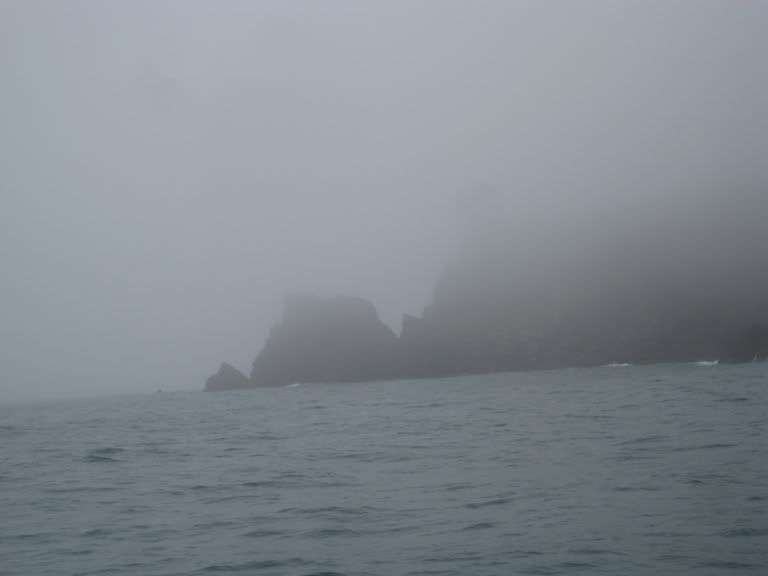 [/caption]
[/caption]
[caption id="" align="alignnone" width="300" caption="Porthllysgi"]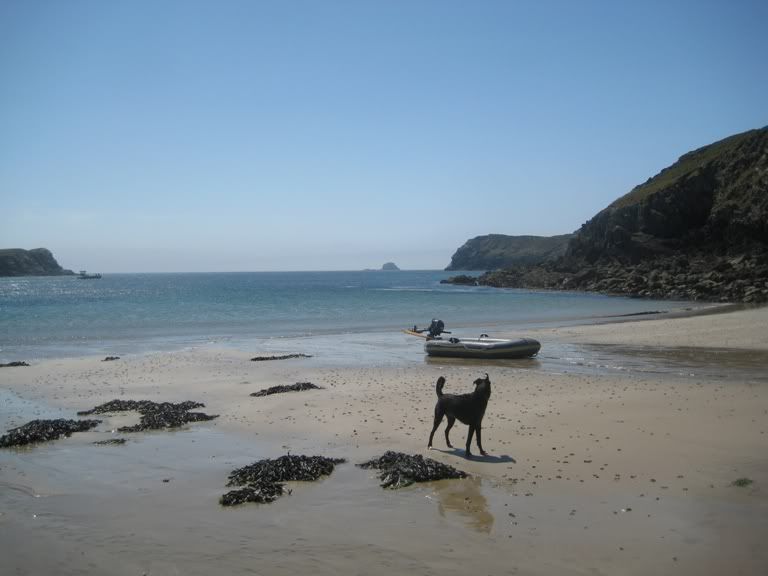 [/caption]
[/caption]
[caption id="" align="alignnone" width="300" caption="Downwind"] [/caption]
[/caption]
[caption id="" align="alignnone" width="300" caption="Bang"]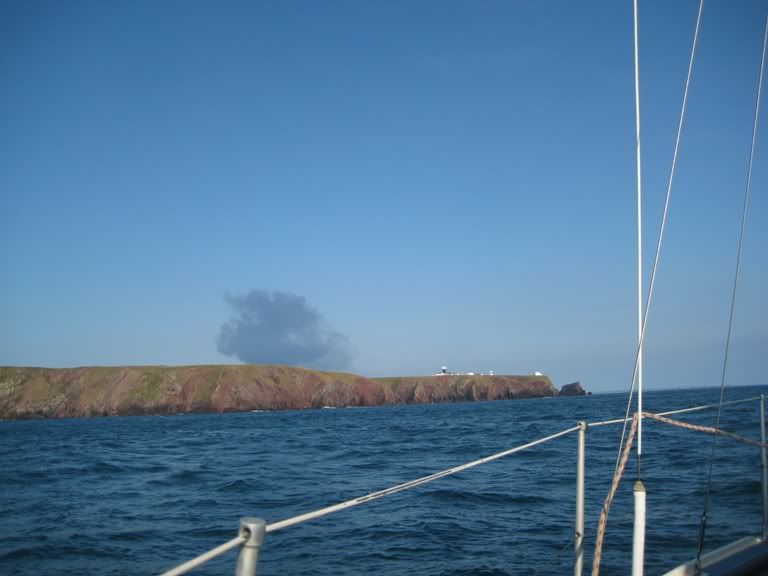 [/caption]
[/caption]
[caption id="" align="alignnone" width="300" caption="Dale"]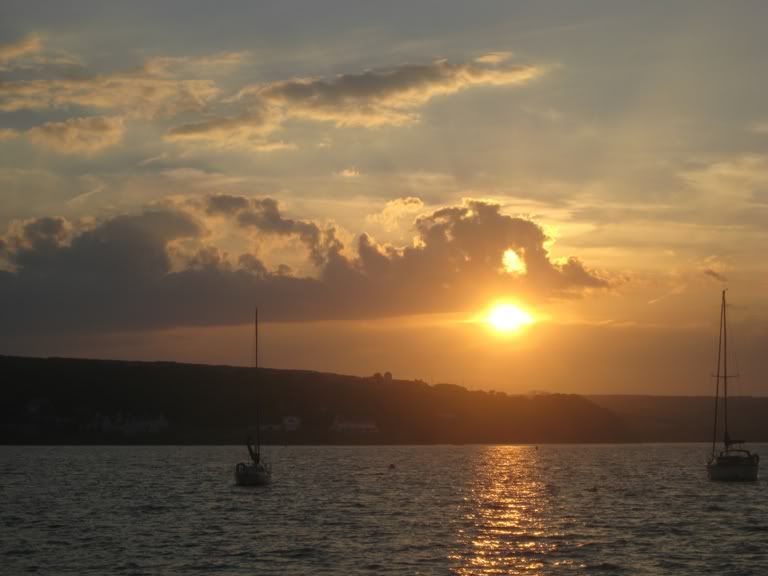 [/caption]
[/caption]
Tigger had had a good run on the beach, and was tired.
[caption id="" align="alignnone" width="300" caption="Tired"]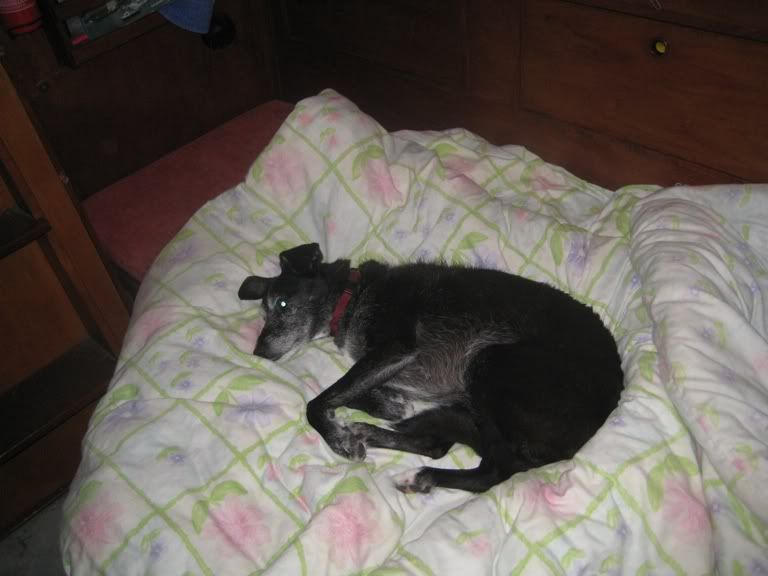 [/caption]
[/caption]
The following day I ran the engine for a 15 minute trip around to Castlebeach bay. I thought that the diesel treatment had had 24 hrs to work on the main tank, and pulling some of the treatment through the filters would make sense. Tigger had a run on the beach and we were joined by a couple of other yachts.
[caption id="" align="alignnone" width="300" caption="Castlebeach"]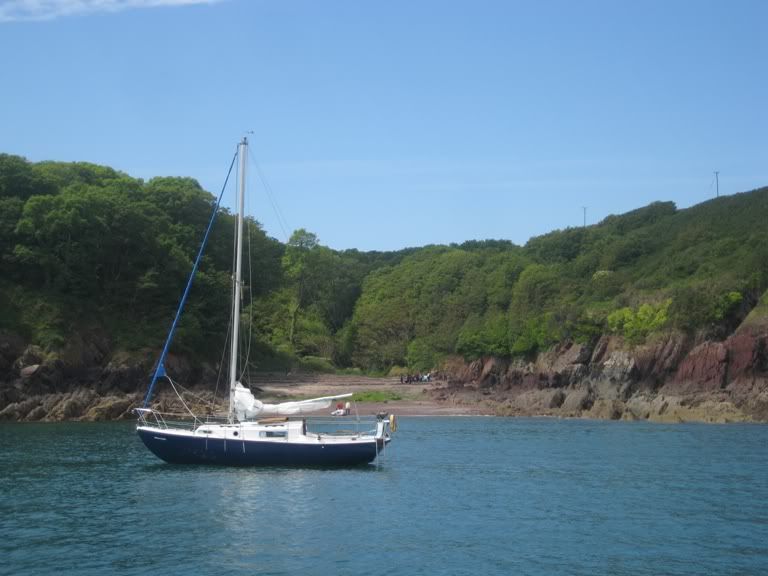 [/caption]
[/caption]
Portishead
which was very frustrating, and in the worst possible place. Now it's happened again, but I think we've git to the bottom of it.......
The forecast was for lighter winds later in the week. I woke early and planned a trip North, up towards Ramsey Island or beyond. The 07:50 forecast mentioned fog patches and poor visibility, and they were not wrong:
[caption id="" align="alignnone" width="300" caption="St Anne's head"]
 [/caption]
[/caption]I have to admit, fog is perhaps my least favourite weather condition. Even the most familiar landscapes seem foreign, and a GPS failure would be very worrying. With high pressure, light winds and warm temperatures forecast, though, I figured it would burn off. As we passed Skokholm, it already seemed thinner, and I estimated the visibility was maybe half a mile now. Staying close in near the islands should also ensure I'd encounter no shipping.
I knew I'd missed the Jack Sound slack, and the tide picked up as I motored around the West coast of Skomer, slowing my progress considerably until I turned into St Brides bay and out of the foul tide. As I switched to sail, the fog lifted, and I could see the tankers moored, waiting to be called into the Haven. I headed for Porthllysgi bay, pondering whether to head through Ramsey Sound at the next slack and then on up to Fishguard for the night.
I dropped the anchor at Porthllysgi and took Tigger ashore.
[caption id="" align="alignnone" width="300" caption="Porthllysgi"]
 [/caption]
[/caption]Porthllysgi is a picturesque little bay about a mile or so to the East of Ramsey Sound, facing Southwest. There are a couple of wrecks in the bay, which we've dived many times, so I anchored under the cliffs. Tigger would like to point out that the bay has excellent facilities for dogs, sand, water, and a good supply of sticks.
We returned to the boat and finished off the last of the ciabattas, tomatoes and goat's cheese. The wind picked up from the North and, as Porthllysgi is in a shallow valley, funnelled towards us. It was only three o'clock, and as soon as the idea entered my head, the thought of a lovely downwind sail back to Dale won me over, and we set off.
[caption id="" align="alignnone" width="300" caption="Downwind"]
 [/caption]
[/caption]As I neared Skomer, I knew the tide would turn Northwards again, against us. We'd been tearing along at over 6 nots through the water, near Ishtar's hull speed, but that halved as we approached the island, so I switched the engine on, intent on motoring around the corner into Broad Sound.
When the engine suddenly died, right on the West tip of Skomer, in the strongest part of the tide, I was dumbstruck. It had happened again, at the worst possible time. Several attempts to restart it failed. I was still sailing at 3 knots, and that started to increase as I turned into Broad Sound. My options were clear, sail back to Dale and sort the problem out there.
The tide was picking up against me, but there was plenty of wind, and I turned onto a broad reach sailing SouthEasterly towards St Anne's head. At 5 knots over the ground there should be no problem. When I passed St Anne's I'd have to sail upwind, but the tide should help, taking me into the haven. As I approached St Anne's I heard a huge 'thump' of an explosion. I thought it was something on Castlemartin firing range, until I saw the cloud.
[caption id="" align="alignnone" width="300" caption="Bang"]
 [/caption]
[/caption]I found out later that it was an explosion at the Chevron refinery, and that sadly, 4 people had lost their lives. Made my position seem trivial, though I didn't know it at the time.
I entered the Haven and made good progress towards Dale. I could not believe it when, within sight of the moorings, with less than 400 yards to go, the wind died completely. By this time the tide was going out, and I started to drift away from Dale.
I shouted to some dinghies and their safety boat to no avail. Quickly I fitted the outboard to the inflatable, but only succeeded in towing Ishtar around in circles. I could not believe I had failed, and would need to call the coastguard. At the last minute, I spied another yacht and Kevin, Chris and Kath, aboard their yacht Kaiku, kindly towed me the last few yards, just as, ironically, the wind sprang up again. I took Tigger ashore and had a beer. The problem would wait until tomorrow.
I'd resigned to spending the whole day trying to find the problem, but in the end I found it quickly. No diesel was reaching the engine. The pipe that was blocked last time seemed free - this time it looked like the filter. My heart sank as I stripped it, and saw lumps of black slime blocking it. It seemed we had the 'diesel bug' and it was probably this, not a lump of black rubber that caused the problem in Portishead.
I spent the rest of the day cleaning all the pipes and changed the filter. I used a diving cylinder to blow lumps of slime out of the pipes. Eventually, the engine started again and ran well, but I still had the bug and it would surely recur. I did some research on the Internet (via my phone) and decided to try one of the treatments. Whatever I could get my hands on for now, and then maybe a better solution when I could do some proper research.
The following morning I rang Dale Sailing in Neyland. They had a couple of products so I drove there. They had a copy of a magazine review of diesel bug killers, and I bought the recommended one, 'Marine 16'. I dropped a dose in the tank and let it do its work. I didn't want to risk leaving the mooring with Ishtar, and probably dragging more slime into the now clean pipes. I settled down for a bit of reading, Thoreau's 'Walden', listening to the cricket, a king Prawn curry and a bottle of Crabbies alcoholic ginger beer. Life isn't that bad really.
[caption id="" align="alignnone" width="300" caption="Dale"]
 [/caption]
[/caption]On the pontoon later that evening, I spied this beautiful vessel. Not sure what she was, possibly an old lifeboat?
Tigger had had a good run on the beach, and was tired.
[caption id="" align="alignnone" width="300" caption="Tired"]
 [/caption]
[/caption]The following day I ran the engine for a 15 minute trip around to Castlebeach bay. I thought that the diesel treatment had had 24 hrs to work on the main tank, and pulling some of the treatment through the filters would make sense. Tigger had a run on the beach and we were joined by a couple of other yachts.
[caption id="" align="alignnone" width="300" caption="Castlebeach"]
 [/caption]
[/caption]A few hours later we were back on the mooring. I decided to leave the diesel treatment in the tank for a week and review the situaution next weekend.
Labels:
diesel bug,
Sailing,
yacht
Monday 6 June 2011
A couple of days in the Haven
The frustrating days aboard the junk, being in and around a yacht without actually sailing had left me hungry for the real thing. Tigger and I jumped in the car on Monday and headed down to the boat. A bit of tidying up and I took Ishtar in to the pontoon near the Griffin. Two of the largest, and most expensive looking vessels I'd seen moored there were tied alongside:
[caption id="" align="alignnone" width="300" caption="Expensive"]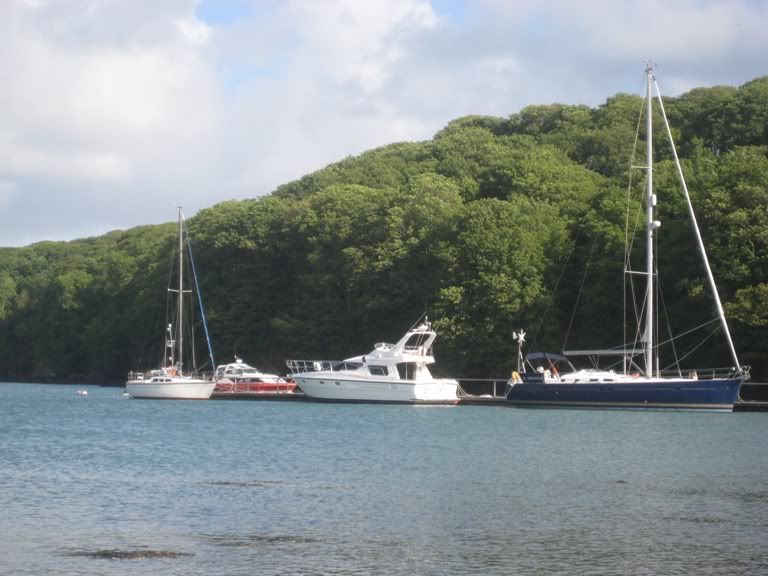 [/caption]
[/caption]
The following morning I set off up the Haven. The forecast was for 5s and 6s, but getting better in a day or two. I'd planned to anchor overnight at Crow Pool, Pennar Gut, and had a lovely sail up past the tankers waiting to empty or fill up.
[caption id="" align="alignnone" width="300" caption="Tanker"] [/caption]
[/caption]
I sailed up past Milford, almost to Neyland before switching on the engine and heading for the narrow entrance to Pennar Gut. The wind was quite strong from the West now, and, as I dropped anchor, after circling to survey the depth, I was concerned the anchor might drag.
After half an hour I gave the engine a burst astern. Solid, with a nice bounce back on the chain - seemed like a secure anchorage indeed. A small ferry left the Power station pontoon and headed out into the main Haven
[caption id="" align="alignnone" width="300" caption="Power station ferry"]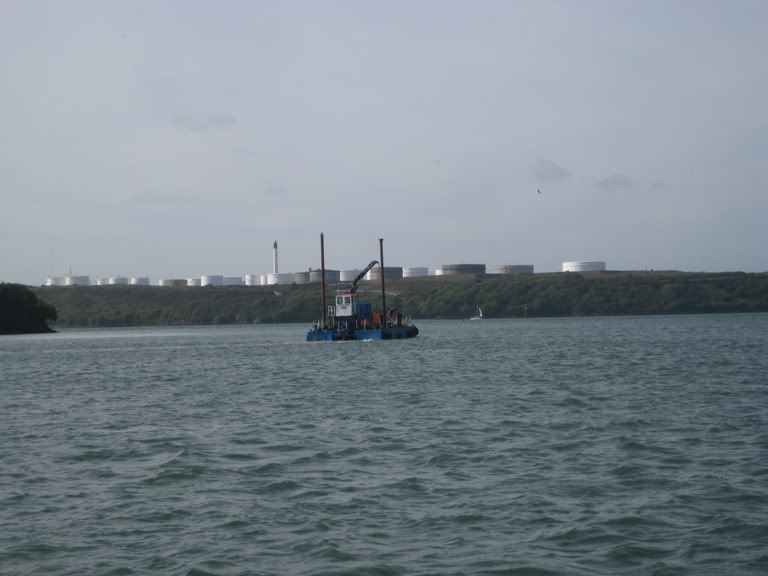 [/caption]
[/caption]
As the tide fell, however, I realised there was a problem with the anchorage I hadn't forseen earlier. I try and take Tigger ashore each morning and evening. With the falling tide, the 'beach' appeared to be mainly thick mud. Not fancying that, I decided to abandon, and head back to Dale. I pulled the anchor up and quickly saw that the thick mud extended out to where I was anchored, explaining the firmness I'd felt when testing it.
I stopped at Milford, taking Tigger ashore and calling in Tesco's for a bottle of Sauvingon blanc before heading back to our mooring as the sun dipped towards the horizon.
[caption id="" align="alignnone" width="300" caption="Setting sun"]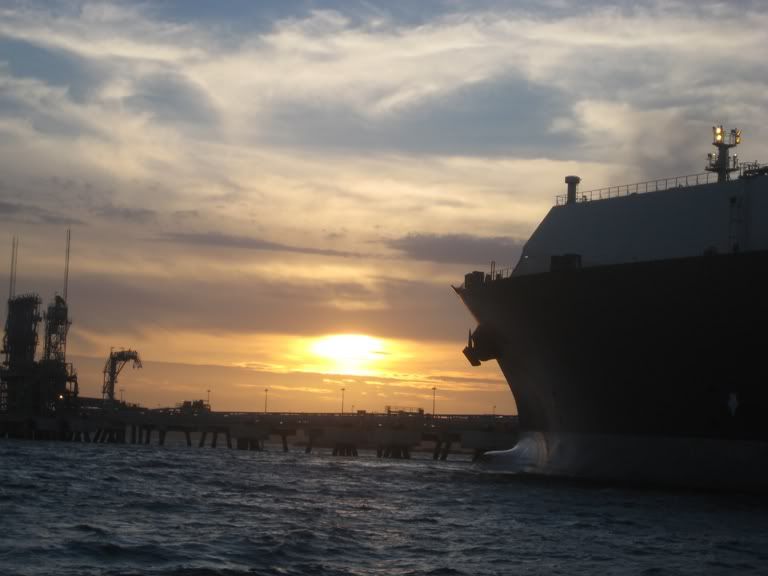 [/caption]
[/caption]
I received news that an old college friend, Dave would be visiting the following day, and met him on the pontoon at 11:00. We both agreed that 'pottering about the haven' and discussing old times would be preferable to a hard day's sail outside the Haven. We set off passing Castlebeach and Monk's Haven before anchoring at Langoar bay, Sandy Haven.
Dave was keen to display his expert fishing skills, and kitted up whilst I prepared a lunch of some ciabattas, tomatoes, onions and goat's cheese. After lunch it didn't take long for Dave to demonstrate his prowess.
[caption id="" align="alignnone" width="300" caption="Dave Black"]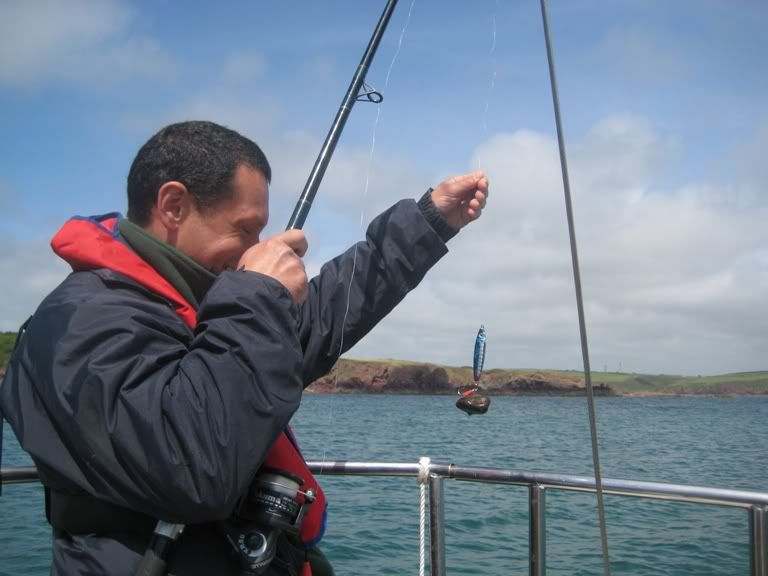 [/caption]
[/caption]
It may be difficult to see from the picture, but he'd caught a slipper limpet, still attached to its rock. There are few people I know skilled enough to entice a slipper limpet to chase a spinning lure, but Dave managed it. He returned it unharmed to the deep. He later returned the lure unharmed to the deep as well. He didn't seem bothered, since he hadn't bought it. Before leaving, we went for a walk to Westdale beach, where we briefly spied some fox cubs we'd been told about, and also spotted their parent, presumably out hunting for a late meal for them.
A lovely day.
[caption id="" align="alignnone" width="300" caption="Expensive"]
 [/caption]
[/caption]There was nobody about that I knew, but it's nice to give Tigger a bit of time playing on the beach - sailing itself bores him quite a bit, but beaches, sticks, sand and water get his attention nicely.
The following morning I set off up the Haven. The forecast was for 5s and 6s, but getting better in a day or two. I'd planned to anchor overnight at Crow Pool, Pennar Gut, and had a lovely sail up past the tankers waiting to empty or fill up.
[caption id="" align="alignnone" width="300" caption="Tanker"]
 [/caption]
[/caption]I sailed up past Milford, almost to Neyland before switching on the engine and heading for the narrow entrance to Pennar Gut. The wind was quite strong from the West now, and, as I dropped anchor, after circling to survey the depth, I was concerned the anchor might drag.
After half an hour I gave the engine a burst astern. Solid, with a nice bounce back on the chain - seemed like a secure anchorage indeed. A small ferry left the Power station pontoon and headed out into the main Haven
[caption id="" align="alignnone" width="300" caption="Power station ferry"]
 [/caption]
[/caption]As the tide fell, however, I realised there was a problem with the anchorage I hadn't forseen earlier. I try and take Tigger ashore each morning and evening. With the falling tide, the 'beach' appeared to be mainly thick mud. Not fancying that, I decided to abandon, and head back to Dale. I pulled the anchor up and quickly saw that the thick mud extended out to where I was anchored, explaining the firmness I'd felt when testing it.
I stopped at Milford, taking Tigger ashore and calling in Tesco's for a bottle of Sauvingon blanc before heading back to our mooring as the sun dipped towards the horizon.
[caption id="" align="alignnone" width="300" caption="Setting sun"]
 [/caption]
[/caption]I received news that an old college friend, Dave would be visiting the following day, and met him on the pontoon at 11:00. We both agreed that 'pottering about the haven' and discussing old times would be preferable to a hard day's sail outside the Haven. We set off passing Castlebeach and Monk's Haven before anchoring at Langoar bay, Sandy Haven.
Dave was keen to display his expert fishing skills, and kitted up whilst I prepared a lunch of some ciabattas, tomatoes, onions and goat's cheese. After lunch it didn't take long for Dave to demonstrate his prowess.
[caption id="" align="alignnone" width="300" caption="Dave Black"]
 [/caption]
[/caption]It may be difficult to see from the picture, but he'd caught a slipper limpet, still attached to its rock. There are few people I know skilled enough to entice a slipper limpet to chase a spinning lure, but Dave managed it. He returned it unharmed to the deep. He later returned the lure unharmed to the deep as well. He didn't seem bothered, since he hadn't bought it. Before leaving, we went for a walk to Westdale beach, where we briefly spied some fox cubs we'd been told about, and also spotted their parent, presumably out hunting for a late meal for them.
A lovely day.
Subscribe to:
Posts (Atom)


